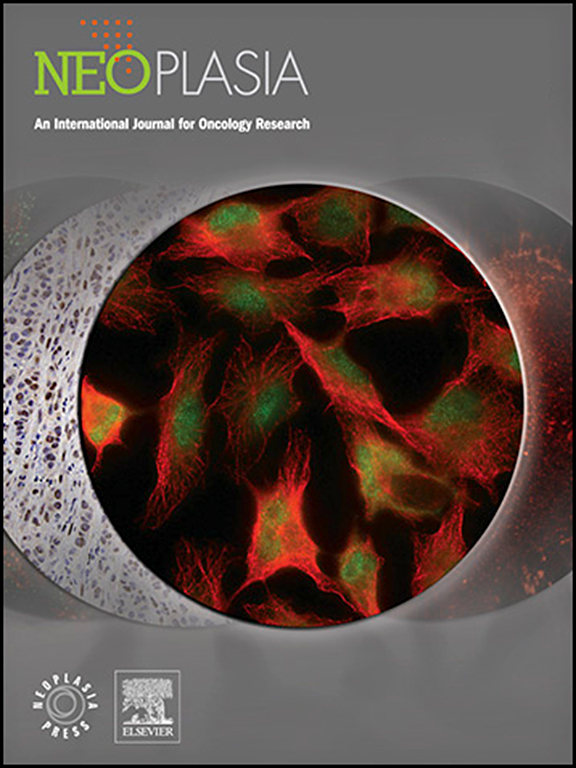内分泌治疗抵抗性乳腺癌免疫治疗hla - a2限制性新表位的筛选和鉴定
IF 7.7
2区 医学
Q1 Biochemistry, Genetics and Molecular Biology
引用次数: 0
摘要
内分泌治疗在雌激素受体α (ERα)阳性乳腺癌治疗中显示出显著的临床疗效,但治疗耐药突变的出现显著破坏了治疗结果,经常导致疾病进展和转移。在这些耐药机制中,ESR1基因的突变尤其普遍,在76%的内分泌治疗耐药肿瘤标本中可检测到。来自突变体ESR1的免疫原性新表位的鉴定为内分泌治疗抵抗性乳腺癌患者提供了一条有希望的治疗途径。在这项研究中,我们系统地研究了ESR1在各种癌症类型中的突变景观,特别强调突变频率和频谱分析。我们的研究结果显示,非同义ESR1突变主要发生在乳腺癌中,聚集在四个不同的热点位点:K303、E380、Y537和D538。我们进一步描述了不同乳腺癌亚型在这些热点的突变流行率。通过综合筛选,我们从ESR1热点突变中鉴定出8个人类白细胞抗原(HLA)-A*0201限制性免疫原性新表位。这些新表位在体内和体外都能引起特异性的细胞毒性T淋巴细胞(ctl)反应。诱导的ctl对携带突变新表位的T2A2细胞和携带编码突变新表位的minigene的HLA-A*0201阳性乳腺癌细胞均表现出特异性识别和细胞毒活性。值得注意的是,用含有这8个新表位的肽池启动的T细胞过继转移可显著抑制肿瘤生长并增强CD8+ T细胞在肿瘤组织中的浸润。这些发现表明,已鉴定的新表位代表了开发肿瘤共享新抗原疫苗的有希望的候选者。本文章由计算机程序翻译,如有差异,请以英文原文为准。
Screening and identification of HLA-A2-restricted neoepitopes for immunotherapy in endocrine therapy-resistant breast cancer
Endocrine therapy has shown significant clinical efficacy in estrogen receptor alpha (ERα)-positive breast cancer management, but the emergence of therapy-resistant mutations significantly undermines treatment outcomes, frequently leading to disease progression and metastasis. Among these resistance mechanisms, mutations in the ESR1 gene are particularly prevalent, detectable in 76% of endocrine therapy-resistant tumor specimens. The identification of immunogenic neoepitopes derived from mutant ESR1 offers a promising therapeutic avenue for patients with endocrine therapy-resistant breast cancer. In this study, we systematically investigated the mutational landscape of ESR1 across various cancer types, with particular emphasis on mutation frequency and spectrum analysis. Our findings revealed that non-synonymous ESR1 mutations predominantly occurred in breast cancer, clustering at four distinct hotspot sites: K303, E380, Y537 and D538. We further characterized the mutation prevalence at these hotspots across different breast cancer subtypes. Through comprehensive screening, we identified eight human leukocyte antigen (HLA)-A*0201 restricted immunogenic neoepitopes derived from ESR1 hotspot mutations. These neoepitopes demonstrated the capacity to elicit specific cytotoxic T lymphocytes (CTLs) responses both in vitro and in vivo. The induced CTLs exhibited specific recognition and cytotoxic activity against both T2A2 cells loaded with mutant neoepitopes and HLA-A*0201-positive breast cancer cells transfected with minigene encoding mutant neoepitopes. Notably, adoptive transfer of T cells primed with a peptide pool containing these eight neoepitopes significantly suppressed tumor growth and enhanced CD8+ T cells infiltration within tumor tissue. These findings suggest that the identified neoepitopes represent promising candidates for the development of tumor shared neoantigen vaccines.
求助全文
通过发布文献求助,成功后即可免费获取论文全文。
去求助
来源期刊

Neoplasia
医学-肿瘤学
CiteScore
9.20
自引率
2.10%
发文量
82
审稿时长
26 days
期刊介绍:
Neoplasia publishes the results of novel investigations in all areas of oncology research. The title Neoplasia was chosen to convey the journal’s breadth, which encompasses the traditional disciplines of cancer research as well as emerging fields and interdisciplinary investigations. Neoplasia is interested in studies describing new molecular and genetic findings relating to the neoplastic phenotype and in laboratory and clinical studies demonstrating creative applications of advances in the basic sciences to risk assessment, prognostic indications, detection, diagnosis, and treatment. In addition to regular Research Reports, Neoplasia also publishes Reviews and Meeting Reports. Neoplasia is committed to ensuring a thorough, fair, and rapid review and publication schedule to further its mission of serving both the scientific and clinical communities by disseminating important data and ideas in cancer research.
 求助内容:
求助内容: 应助结果提醒方式:
应助结果提醒方式:


